
Da-Capo [1] is a chocolate bar produced by the Finnish company Fazer since 1916. Da-Capo was Fazer's first chocolate bar.

Da-Capo [1] is a chocolate bar produced by the Finnish company Fazer since 1916. Da-Capo was Fazer's first chocolate bar.
From 1916 to 1939 Da-Capo was sold as paper-wrapped pralines. The name Da-Capo comes from the musical term da capo (redo from start), because it was invented as a recycling idea when the company wanted to reuse liqueur pralines that failed quality control. The pralines were melted down and Rhum Martinique was added to the mix, soothing the liqueur taste down. [2] Da-Capo has been produced as a chocolate bar since 1949, and the wrapped pralines returned to the market in 1957. The pralines had been away from the market for some time, but nowadays they are sold at Christmas time and in travel sortiments at airports.
Da-Capo is sold as a chocolate bar weighing 20 grams, [3] in praline boxes of three kilograms and 350 grams and in bags on 130 grams.
The alcohol content in Da-Capo is minimal, as the chocolate mass is cooked to 110 degrees Celsius, causing most of the alcohol to evaporate. The rum content of the chocolate bar might still have an effect in a breath analysis test, if the test is done immediately after eating a Da-Capo bar. [4] The mass is coated in dark chocolate. [2]

Chocolate or cocoa is a food made from roasted and ground cacao seed kernels that is available as a liquid, solid, or paste, either on its own or as a flavoring agent in other foods. Cacao has been consumed in some form for at least 5,300 years starting with the Mayo-Chinchipe culture in what is present-day Ecuador and later Mesoamerican civilizations also consumed chocolate beverages before being introduced to Europe in the 16th century.
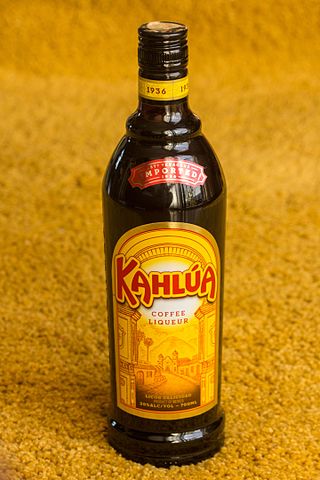
Kahlúa is a brand of coffee liqueur owned by the Pernod Ricard company and produced in Veracruz, Mexico. The drink contains rum, sugar, and arabica coffee.

A chocolate bar is a confection containing chocolate, which may also contain layerings or mixtures that include nuts, fruit, caramel, nougat, and wafers. A flat, easily breakable, chocolate bar is also called a tablet. In some varieties of English and food labeling standards, the term chocolate bar is reserved for bars of solid chocolate, with candy bar used for products with additional ingredients.
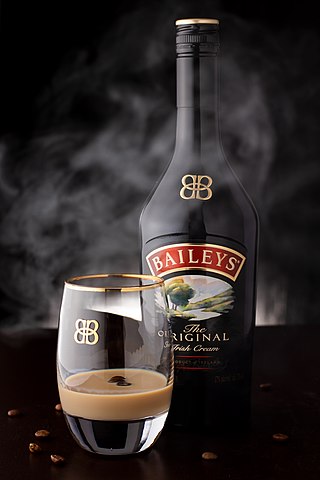
Baileys Irish Cream is an Irish cream liqueur made of cream, cocoa and Irish whiskey emulsified together with vegetable oil. Baileys is made by Diageo at Nangor Road, in Dublin, Ireland and in Mallusk, Northern Ireland. It is the original Irish cream, invented by a team headed by Tom Jago in 1971 for Gilbeys of Ireland; Diageo currently owns the trademark. It has a declared alcohol content of 17% by volume.

Milk chocolate is a form of solid chocolate containing cocoa, sugar and milk. It is the most consumed type of chocolate, and is used in a wide diversity of bars, tablets and other confectionery products. Milk chocolate contains smaller amounts of cocoa solids than do dark chocolates, and contains milk solids. While its taste has been key to its popularity, milk chocolate was historically promoted as a healthy food, particularly for children.

Kit Kat is a chocolate-covered wafer bar confection created by Rowntree's of York, United Kingdom. It is produced globally by Nestlé, except in the United States, where it is made under licence by the H. B. Reese Candy Company, a division of the Hershey Company.
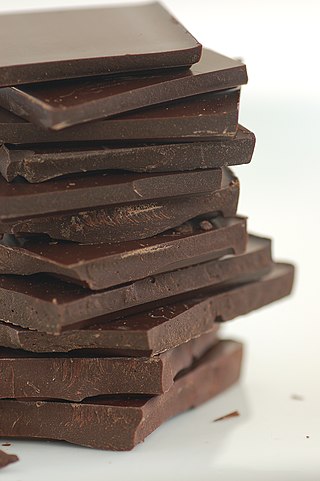
A chocoholic is a person who craves or compulsively consumes chocolate. The word "chocoholic" was first used in 1968, according to Merriam-Webster. It is a portmanteau of "chocolate" and "alcoholic". The term is used loosely or humorously to describe a person who is inordinately fond of chocolate; however, there is medical evidence to support the existence of actual addiction to chocolate. Psychoactive constituents of chocolate that trigger a ‘feel-good’ reaction for the consumer include tryptophan and phenylethylamine, which may contribute to cravings and addiction-like responses, particularly in people with specific genetic alleles. The quantity of sugars used in chocolate confections also impacts the psychoactive effects of chocolate.
Curaçao is a liqueur flavored with the dried peel of the bitter orange laraha, a citrus fruit grown on the Caribbean island of Curaçao.

White chocolate is a confectionery typically made of sugar, milk, and cocoa butter, but no cocoa solids. It is pale ivory in color, and lacks many of the compounds found in milk, dark, and other chocolates. It is solid at room temperature because the melting point of cocoa butter, the only white cocoa bean component, is 35 °C (95 °F).

Fazer is one of the largest corporations in the Finnish food industry. The company was founded by Karl Fazer in 1891, as a "French-Russian confectionery" in central Helsinki. Today, it employs over 6,000 people across Finland, Sweden, Latvia, Lithuania, Estonia, Denmark, Norway and Poland. Its products are exported to more than 40 countries.

A chocolate truffle is a French chocolate confectionery traditionally made with a chocolate ganache center and coated in cocoa powder, coconut, or chopped nuts. A chocolate truffle is handrolled into a spherical or ball shape. The name derives from the chocolate truffle's similarity in appearance to truffles, a tuber fungus. It was created in the city of Chambéry by the pastry chef Nicole Petruccelli.

Chocolate is a food product made from roasted and ground cocoa pods mixed with fat and powdered sugar to produce a solid confectionery. There are several types of chocolate, classified primarily according to the proportion of cocoa and fat content used in a particular formulation.

Swiss chocolate is chocolate produced in Switzerland. While cacao beans and other ingredients such as sugar cane originate from outside Switzerland, the actual production of the chocolate must take place in Switzerland. Switzerland's chocolates have earned an international reputation for high quality with many famous international chocolate brands.
The U-NO Bar is produced by the Annabelle Candy Company.

Dry cocoa solids are the components of cocoa beans remaining after cocoa butter, the fatty component of the bean, is extracted from chocolate liquor, roasted cocoa beans that have been ground into a liquid state. Cocoa butter is 46% to 57% of the weight of cocoa beans and gives chocolate its characteristic melting properties. Cocoa powder is the powdered form of the dry solids with a small remaining amount of cocoa butter. Untreated cocoa powder is bitter and acidic. Dutch process cocoa has been treated with an alkali to neutralize the acid.

Belgian chocolate is chocolate produced in Belgium. A major industry since the 19th century, today it forms an important part of the nation's economy and culture.
The following outline is provided as an overview of and topical guide to chocolate:
Chocolat Jacques is a Belgian firm that was founded in Verviers in 1896, by Antoine Jacques (1858-1929). Production was later moved to Bruges and Eupen in the east of Belgium, where its headquarters have also been located since 1923.
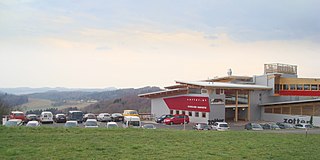
Zotter Schokolade is an Austrian chocolate manufacturer specializing in organic and fairly traded bean-to-bar chocolate. The company was founded in 1999 by Josef Zotter and is based in Riegersburg, Styria. Zotter is mostly active in German-speaking Europe, with 90 percent of distribution outlets being located in Germany, Switzerland, and Austria. As one of Austria's most well-known trademarks, Zotter is considered a national high equity brand.
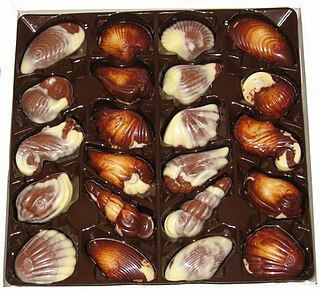
Fruits de mer is a type of Belgian chocolate pralines made of dark and milk chocolate with a nougat filling, in the form of various seafood: seahorses, venus clams, mussels, starfish and various sea snails. The pralines are sold in chocolate shops, in supermarkets, and as handmade products in Konditorei shops.